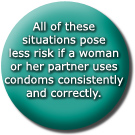Chapter 11
Assessing Women for Risk of Sexually Transmitted Infections
A woman who has gonorrhea or chlamydia now should not have an IUD inserted. Having these sexually transmitted infections (STIs) at the time of insertion may increase the risk of pelvic inflammatory disease. These STIs may be difficult to diagnose clinically, however, and reliable laboratory tests are time-consuming, expensive, and sometimes unavailable. Without clinical signs or symptoms and without laboratory testing, the only indication that a woman might already have an STI is whether her behavior or her situation places her at very high individual risk of infection. If this risk for the individual client is very high, she generally should not have an IUD inserted.‡ (Local STI prevalence rates are not a basis for judging individual risk.)
There is no universal set of questions that will determine if a woman is at very high individual risk for STIs. Instead of asking questions, providers can discuss with the client the personal behaviors and the situations in their community that are most likely to expose women to STIs.
Steps to take:
1. Tell the client that a woman who faces a very high individual risk of STIs usually should not have an IUD inserted.
2. Ask the woman to consider her own risk and to think about whether she might have an STI. A woman is often the best judge of her own risk.§ She does not have to tell the provider about her behavior or her partner’s behavior. Providers can explain possibly risky situations that may place a woman at very high individual risk. The client can think about whether such situations occurred recently (in the past 3 months or so). If so, she may have an STI now, whether or not she has noticed symptoms, and may want to choose a method other than the IUD.
3. Ask if she thinks she is a good candidate for an IUD or would like to consider other contraceptive methods, including other long-acting methods. If, after considering her individual risk, she thinks she is a good candidate, and she is eligible, provide her with an IUD. If she wants to consider other methods or if you have strong reason to believe that the client is at very high individual risk of infection, help her choose another method.
Possibly risky situations include:
-
A sexual partner has STI symptoms such as pus coming from his penis, pain or burning during urination, or an open sore in the genital area
- She or a sexual partner was diagnosed with an STI recently
- She has had more than one sexual partner recently
- She has a sexual partner who has had other partners recently
Also, a provider can mention other high-risk situations that exist locally.
Note:
If she still wants the IUD while at very high individual risk of STIs, and reliable laboratory testing for gonorrhea and chlamydia is available, a woman who tests negative can have an IUD inserted. A woman who tests positive can have an IUD inserted as soon as she finishes treatment, if she is not at risk of reinfection by the time of insertion.
In special circumstances, if other, more appropriate methods are not available or not acceptable, a health care provider who can carefully assess a specific woman’s condition and situation may decide that a woman at very high individual risk can have the IUD inserted even if STI testing is not available. (Depending on the circumstances, the provider may consider presumptively treating her with a full curative dose of antibiotics effective against both gonorrhea and chlamydia and inserting the IUD after she finishes treatment.) Whether or not she receives presumptive treatment, the provider should be sure that the client can return for the follow-up visit, will be carefully checked for infection, and will be treated immediately if needed. She should be asked to return at once if she develops a fever and either lower abdominal pain or abnormal vaginal discharge or both.
‡ In contrast, if a current IUD user’s situation changes and she finds herself at very high individual risk for gonorrhea or chlamydia, she can keep using her IUD.
§ Any woman who thinks she might have an STI should seek care immediately.